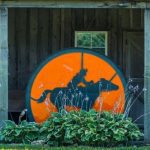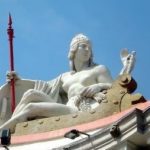 Music
Music  Music
Music  History
History 10 Less Than Jolly Events That Occurred on December 25
 Weird Stuff
Weird Stuff 10 Funny Ways That Researchers Overthink Christmas
 Politics
Politics 10 Political Scandals That Sent Crowds Into the Streets
 Weird Stuff
Weird Stuff Ten Bizarre Facts About The Doge Meme
 Our World
Our World 10 Ways Your Christmas Tree Is More Lit Than You Think
 Movies and TV
Movies and TV The 10 Coolest Stars to Set Sail on The Love Boat
 History
History 10 Things You Didn’t Know About the American National Anthem
 Technology
Technology Top 10 Everyday Tech Buzzwords That Hide a Darker Past
 Humans
Humans 10 Everyday Human Behaviors That Are Actually Survival Instincts
 Music
Music 10 Surprising Origin Stories of Your Favorite Holiday Songs
 History
History 10 Less Than Jolly Events That Occurred on December 25
 Weird Stuff
Weird Stuff 10 Funny Ways That Researchers Overthink Christmas
Who's Behind Listverse?

Jamie Frater
Head Editor
Jamie founded Listverse due to an insatiable desire to share fascinating, obscure, and bizarre facts. He has been a guest speaker on numerous national radio and television stations and is a five time published author.
More About Us Politics
Politics 10 Political Scandals That Sent Crowds Into the Streets
 Weird Stuff
Weird Stuff Ten Bizarre Facts About The Doge Meme
 Our World
Our World 10 Ways Your Christmas Tree Is More Lit Than You Think
 Movies and TV
Movies and TV The 10 Coolest Stars to Set Sail on The Love Boat
 History
History 10 Things You Didn’t Know About the American National Anthem
 Technology
Technology Top 10 Everyday Tech Buzzwords That Hide a Darker Past
 Humans
Humans 10 Everyday Human Behaviors That Are Actually Survival Instincts
10 Terrible Crimes That Are Destroying the Amazon
The Amazon rainforest covers more than 2.3 million square miles (5.96 square kilometers) and is home to several million species of birds, plants, insects, and other forms of life. The rainforest is also home to several indigenous communities that live off the land. However, the area is now in danger of being taken over by criminals. These people are illegally selling land in the Amazon to be used for other illegal activities such as drug production, illegal logging, illegal wildlife trade, and even illegal mining. Here are ten terrible crimes that are adding to the deforestation of the Amazon rainforest.
Related: 10 Weird Wildlife Conservation Strategies That Actually Worked
10 Cocaine Production
One of the biggest crimes currently happening in the depths of the Amazon is the production of cocaine. Cocaine contains a white crystalline alkaloid that is obtained from the leaves of the coca plant. The coca plant is easy to grow with three crops a year, and it has been a part of the culture of nearby communities. Unfortunately, organized crime groups are moving into the area and taking over the growth of the plant from the Indigenous peoples.
These criminal organizations have expanded their presence in the Amazon, forcing locals to work for them and paying them little money. They are creating new paths through the forest and destroying parcels of land for new coca plants. The locals fear for their lives as the area is taken over by the criminals who grow the crop, and it continues to get worse each year. People are dying during the production, it’s contributing to a global drug crisis, and it’s a leading factor in the deforestation of the Amazon rainforest.[1]
9 Trafficking
All types of trafficking are actively happening in the Amazon, including human trafficking, drug trafficking, and wildlife trafficking. Sex trafficking is on the rise in the Amazon, but child trafficking for labor is becoming a more significant problem. Many of the children who work as prostitutes in Brazil end up being sold for labor in the gold mines of the Amazon.
For the drug trafficking business to be successful in the Amazon, the forest needs to be cleared out, which leads to timber trafficking as well. These criminals have moved into the Amazon to hide the manufacturing of drugs, and then they distribute and sell the drugs. The drug dealers use cattle ranching to cover up their business. They can conceal airstrips and buildings on the ranching land and go unnoticed.
Many of the places where drug trafficking is occurring are areas deep in the forest that are hard to access and are in protected areas. In 2020, almost half of all coca cultivation in Colombia took place in areas that were indigenous or protected. The Indigenous communities either flee the area or are subjected to violence and exploitative work conditions while deforestation continues to kill the Amazon.[2]
8 Illegal Land Sales
Large plots of land in the Amazon were being illegally sold on Facebook, and many of the plots were in the indigenous reserves. People are illegally moving into these areas and “claiming” land for sale. They have been caught listing these plots on Facebook for the use of illegal cattle farming, drug manufacturing, and illegal logging. Selling plots of land to these criminals only furthers the deforestation of the Amazon, and it takes jobs and land from the Indigenous peoples.
Brazil’s environmental agency gave out 20% fewer fines in 2020 than they did one year earlier, which is mostly due to budget cuts and staff reductions. Social media has made it easier for criminals to beat the system and help sell land even quicker.[3]
7 Illegal Fires
Once these parcels of land are either sold or stolen from criminals, they start carrying out their plans for the land. The first action is to clear the land. The trees, bushes, and any other plants or animals are removed from the land, or the entire area is intentionally set on fire to clear everything.
Fires don’t just naturally occur in the Amazon rainforest like they do in the U.S. West; instead, they are intentionally set. In 2021, around 300 fires were detected in the Amazon, burning more than 250,000 acres (101,000 hectares). Once again, due to budget cuts by the Brazilian government, not much is being done to those starting the fires. The number of fires continues to rise each year, killing more of the rainforest, and some environmentalists worry that the damage will soon be irreversible.[4]
6 Illegal Cattle Ranching
Cattle farming is now the main driver of illegal land seizures that violate the rights of Indigenous peoples. Protected land in the Amazon doesn’t seem so protected anymore as unlawful land seizures take place for activities such as cattle ranching. It is estimated that around two-thirds of the areas deforested in the Amazon between 1988 and 2014 have been fenced off and used for cattle farming.
Many Indigenous peoples have described the invasion of their land to be accompanied by violence and threats. These people are technically evicted from their protected areas by criminals taking over the land and told they will be murdered if they return. Some of these illegal cattle ranches are controlled by drug dealers and are used as a front to launder their drug money.[5]
5 Wildcat Mining
Wildcat mining is the term used to describe the operations of illegal mining without a government license and no safety protocols. These types of miners typically dig deeper and illegally clear land to search for resources. Not only is this dangerous for miners, but it also poses a danger to the land and the native people in the mining area. While wildcat mining is illegal in the Amazon, it hasn’t stopped the risky miners from doing it.
These miners are searching for gold and other rich minerals, but it comes at a cost for the Amazon rainforest. The rivers are being destroyed by the dumping of toxic mining by-products known as tailings, and trees are being cut down by the masses. These miners have contributed to the deforestation of the Amazon, polluted nearby rivers, exposed native people to illnesses, and used violence against the Indigenous peoples. Their greed will only increase the danger happening deep in the rainforest.[6]
4 Illegal Wildlife Trade
The illegal wildlife trade happening in the Amazon rainforest is a large business with many different people involved. The major traffickers team up with dealers and suppliers from the area that the animals come from. These major traffickers are generally from North America, Asia, and Europe, and they are linked to other types of illegal activity, such as drugs.
The traffickers encourage the Indigenous people to hunt and capture these wild animals in the forest for large monetary compensation. There are usually high profits being made at the top of the chain with a relatively low risk of being caught or even punished. Wildlife traders often look for birds to buy their feathers, skins, and eggs, and they also search for large reptiles for their highly valued skins. Almost all the mammals that are traded in America come from the Amazon or nearby areas. With limited regulations on wildlife trade, it will only become a bigger business in the future.[7]
3 Illegal Fishing
Illegal fishing mafias move into the small communities in the Amazon with promises of quick profits for the Indigenous peoples in the area. However, these mafias are often violent toward the people in these villages. Many of these fishing mafias have ties to drug trafficking groups, and they carry weapons along with their fishing poles.
They prey on endangered species of fish, such as pirarucu, which are found in protected waters. This fish can grow up to 10 feet (3 meters) long and weigh more than 200 pounds (907 kilograms), and it is considered a delicacy in many Latin American cities. These fish are then smuggled out of the region in wooden barges full of ice and then sold to border towns before being sent to other places.[8]
2 Murder
There were 177 environmental defenders killed in 2022, and one in five murders of those defenders happened in the Amazon rainforest. These land and environmental defenders died trying to protect the planet, and the Amazon is one of the most dangerous places in the world to be a defender, with 39 killings in 2022. Several tourists die each year in the Amazon from drug overdoses, kidnappings, and accidents.
In 2022, British journalist Dom Phillips and Brazilian indigenous expert Bruno Pereira embarked on a reporting trip in the Amazon. Pereira was against illegal fishing in the region, and he was assisting Phillips with research for a book on conservation efforts in the Amazon. When the two were returning from their trip by boat, they were shot, killed, cut up, and buried in the forest.[9]
1 Illegal Logging
One crime that significantly adds to the destruction of the Amazon rainforest is illegal logging. When criminals move into the area and take over tracts of land, whether it be for drug use, cattle farming, or mining, the first course of action is to remove the trees in the area. Between August 2019 and July 2020, illegal loggers cleared about 1.15 million acres (165,500 hectares) of land, which is roughly three times larger than the city of São Paulo. There is no way to accurately specify the number of trees that have been removed, but the number would truly be devastating.
The challenge for authorities is the lack of transparency to distinguish between legal and illegal logging. The licensing process for sustainable forest management plans is a flawed system, and no field inspections are conducted before management plans are created. In this flawed system, there is no way to know how many trees are being removed, and the higher number is fraudulently entered into the system. Even though there are technically legal logging activities happening, more than 10% of the logging taking place is either in conservation units or indigenous reserves, which is always illegal.[10]








